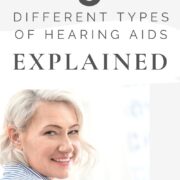The Different Types of Hearing Aids: Explained
You may be wondering what different types of hearing aids are out there.
With so many on the market, it can be tough to know where to even start. Well, don’t worry! This article will break down the different types of hearing aids and give you a good idea of what is available for you.
If you’re considering a hearing aid, you may be wondering what types are available and which one is right for you. This guide will explain the different types of hearing aids, their features, and how they work.
Each type of hearing aid has its own set of features and benefits. You’ll need to consider your lifestyle, budget, and degree of hearing loss when choosing a device. Your audiologist can help you select the best type of hearing aid for your needs.

What is a Hearing Aid?
A hearing aid is a small, battery-operated device that amplifies sound and makes it easier to hear. As seen on the hearing aid store Hear.com, everyone on the planet should hear well to live well.
Hearing aids are worn in or behind the ear. They come in different shapes and sizes and can be customized to fit your individual needs.
Different Types of Hearing Aids
Hearing aids come in a variety of shapes and sizes, each with its own set of features and benefits. Some hearing aids are designed to be nearly invisible, while others offer more robust sound amplification. No matter what your needs are, there’s a hearing aid out there that’s perfect for you.
In-the-ear (ITE) hearing aids are the most visible type of hearing aid, as they sit outside of the ear canal. ITE hearing aids are custom-made to fit the specific shape of your ear and can be used for mild to severe hearing loss.
Behind-the-ear (BTE) hearing aids are larger than ITE models and rest behind the ear. BTE hearing aids are also custom-made, but they’re not as noticeable as ITE models. BTE hearing aids can be used for all types of hearing loss.
Invisible-in-canal (IIC) hearing aids are smaller than ITE models and fit snugly into the ear canal. IIC models aren’t always appropriate for people with certain types of earwax buildup or skin conditions in the ear canal.
Completely-in-canal (CIC) hearing aids are even smaller than IIC models and fit deep inside the ear canal. CIC models aren’t appropriate for people with certain types of earwax buildup or skin conditions in the ear canal.
Receiver-in-canal (RIC) hearing aids are similar in size to BTE models, but the speaker is located in the ear canal. RIC models are appropriate for all types of hearing loss.
Reasons to Get a Hearing Aid
There are many reasons why someone might get a hearing aid. Some people are born with hearing loss, while others develop it over time. It can be caused by exposure to loud noise, certain medical conditions, or the natural aging process.
Hearing loss can have a significant impact on your life. It can make it difficult to communicate with others and enjoy everyday activities. Buying affordable rechargeable hearing aids can help improve your quality of life by making it easier to hear and understand the world around you.
If you think you might benefit from a hearing aid, consider talking to a doctor or audiologist. They can assess your hearing and recommend the best course of treatment.
How to Choose the Best Hearing Aid for You
There are a few things to consider when choosing the best hearing aid for you. First, you need to think about the type of hearing loss you have. There are three main types of hearing loss: conductive, sensorineural, and mixed.
Conductive hearing loss occurs when there is a problem with the ear canal, eardrum, or middle ear bones. This type of hearing loss is often treatable with surgery or other medical interventions.
Sensorineural hearing loss occurs when there is damage to the inner ear or auditory nerve. This type of hearing loss is usually permanent and cannot be corrected with surgery.
Mixed hearing loss is a combination of conductive and sensorineural hearing loss. This type of hearing loss can often be treated with a combination of medical interventions and hearing aids.
Once you know the type of hearing loss you have, you can start looking at different types of hearing aids. There are two main types of hearing aids: analog and digital.
Analog hearing aids use an amplifier to make sounds louder. Digital hearing aids use a computer chip to digitally process sound signals.
Digital hearing aids are more expensive than analog ones, but they offer many benefits over analog models. Digital hearing aids can be programmed to meet your specific needs, and they can be fine-tuned to provide the best possible sound quality.
In addition, digital hearing aids are less likely to produce feedback than analog models.
There are a lot of different hearing aids on the market, and it can be tough to know which one is right for you.
In this article, we’ve gone over the different types of hearing aids so that you can make an informed decision about which one will work best for you. If you have any questions about hearing aids, or if you need help choosing the right one, ask a professional.




